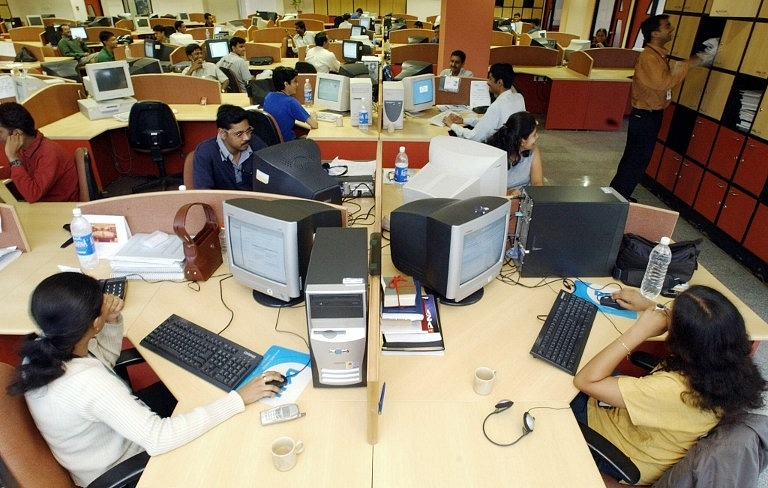Economy
Formal Jobs In India May Be More Than Estimated
- An amnesty scheme by the government which allows firms to come clean on their actual staff strength without being penalised, has caused a 26 per cent jump in the subscriber base of the Employees Provident Fund Organisation (EPFO).

Firms across India came forward to enroll 10.1 million employees under EPFO who were earlier working with them but were not formally reported.
Is India underestimating its formal employment? New data seems to suggest there is a strong likelihood of this indeed being true.
The latest official numbers reveal that the subscriber base of the Employees Provident Fund Organisation (EPFO) rose 26 per cent in the last six months from 38 million to 48.1 million.
The jump is being attributed to an amnesty scheme allowing firms to come clean on their actual staff strength without being penalised.
Not only does it question the employment data—already being scrutinised by a high-level panel headed by NITI Aayog head Arvind Panagariya—it also holds public policy implications, especially on government spending on social welfare programmes.
India, according to census 2011, estimates its workforce at 402 million. According to the labour ministry, as of 2016, India’s labour market comprises more than 475 million people. Of this, it is estimated that less than ten per cent is in formal employment.
The inability to create formal economy jobs haunted the United Progressive Alliance (UPA) government and is now a growing cause for worry for the Bharatiya Janata Party-led National Democratic Alliance (NDA).
As of 30 June, when the scheme deadline expired, firms across India came forward to enroll under EPFO the 10.1 million employees who were earlier working with them but were not formally reported.
“It has surpassed our estimation and expectations. Our amnesty scheme has turned out to be a huge hit and good for the formal economy,” said central provident fund commissioner V P Joy. He added that they had kept a target of ten million, but the actual enrollment has exceeded it.
A fallout of the development is that more employees get access to social security benefits provided in the formal economy. Since the additions are now part of the formal workforce, they are entitled to the prevailing minimum wages, leave encashment benefits and termination benefits in case they are let go, said vice-president of Teamlease Services, Sonal Arora.
“In a way, they will now be covered under the bigger social security net,” she added.
EPFO’s amnesty scheme encouraged companies to enroll workers who had joined them between 1 April 2009 and 31 December 2016. Employees’ contributions, if not collected during the period, were waived. The employers’ contribution will be required to be remitted, but unpaid dues will not attract any penalty. Every month an organised sector employee contributes 12 per cent to EPF, and the employer gives a matching contribution.
The amnesty scheme started on 1 January and ended on 30 June. Overall, EPFO added 10.13 million employees as part of this initiative, said a spokesperson of the retirement fund manager. As on 31 May, the organisation had added 8.2 million subscribers, Mint reported on 13 June.
It means, in June alone, it added over 1.9 million new employees to its subscriber pool, as employers rushed to meet the deadline.
The spokesperson said that the greater than expected enrollment has happened because of the strong response from industrial states such as Gujarat, Rajasthan, Tamil Nadu, Maharashtra, Haryana, Delhi and Uttarakhand. States such as Madhya Pradesh and Uttar Pradesh too reported more than 100 per cent success rate.
“It certainly highlights that the country has underestimated its formal employment for several years. It tells us now that how hundreds of companies under reported their employee strength to deny social security to these millions of workers,” said D L Sachdeva, national secretary of the All India Trade Union Congress, a central labour union.
According to K R Shyam Sundar, a labour economist and professor at XLRI Jamshedpur, the underestimation is deliberate as it helps firms keep their labour costs down.
“I believe the job creation figures over the years are at least 15 to 20 per cent more than what is generally reported because companies under report them to avoid statutory requirements,” said Shyam Sundar.
State-wise data shows Gujarat enrolled 918,000 employees under the amnesty scheme as against an internal estimate of 690,700—a 133 per cent success rate, highest among all states; the Mumbai zone and Maharashtra followed, with 121 per cent and 120 per cent, respectively. EPFO computes data for Mumbai separately.
This article was originally published on Mint and has been republished here with permission.
Introducing ElectionsHQ + 50 Ground Reports Project
The 2024 elections might seem easy to guess, but there are some important questions that shouldn't be missed.
Do freebies still sway voters? Do people prioritise infrastructure when voting? How will Punjab vote?
The answers to these questions provide great insights into where we, as a country, are headed in the years to come.
Swarajya is starting a project with an aim to do 50 solid ground stories and a smart commentary service on WhatsApp, a one-of-a-kind. We'd love your support during this election season.
Click below to contribute.
Latest